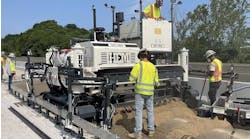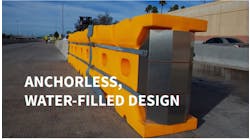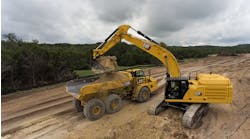If a recession recovery is on its way, it must be on a slow boat from China. Asia, as well as Europe and India, are showing all the signs of reaching economic vitality in the near future, while here in the U.S. any positives seem to be way off in the distance.
According to a Roads & Bridges/Construction Equipment magazines survey, the rest of 2011 will be, at the very best, flat. Everyone from equipment manufacturers to government officials were asked to assess the environment over the next six months, and over 51% responded that business would break even, while 33.5% said it would pick up. However, those numbers seem to carry more of an international tune.
“Exports seem to be driving a lot of [equipment manufacturers’] business right now, as well as rental company orders,” Dennis Slater, president of the Association of Equipment Manufacturers, told Roads & Bridges, “but there is not anything out there that tells you what businesses are really improving.”
ConExpo-Con/Agg 2011, which was held in Las Vegas in March, showed an industry that was gaining confidence following a promising finish to 2010, but even major players like Caterpillar and Volvo were attributing future success to the likes of China and India. When asked how they felt before and after that main event of the year, few R&B/CE respondents wavered on their feelings. Just over 48% said the market was flat prior to ConExpo, and 49.8% felt the same way afterward.
“You had your international customers coming in being very positive and making orders, and you had a lot of domestic customers who were getting ready to get back into business again and that created momentum,” noted Slater. “Once you got deeper into the year here we were counting on some help from the administration to get to that next step, and that has not happened yet.”
Two of the main recovery elements Slater is referring to are free-trade agreements (FTAs) and the passage of a new long-term highway bill. FTAs in Korea, Colombia and Panama have essentially been approved, but are being held up due to what was first human rights issues in those countries and now is the need to retrain American workers who could be displaced due to the agreements.
“These three countries are just going to turn to other countries to do business,” said Slater.
According to the American Road & Transportation Builders Association’s (ARTBA) First Quarter Market Survey, 56% of respondents said they expect spending on equipment to be down over the next year, while 47% indicated leasing would continue to slip. The R&B/CE survey broke it down even further. When asked what type of equipment they would be purchasing over the second half of 2011, on-highway trucks led the way (18.1%), followed by light equipment (17.9%), excavators (17.7%), skid-steer loaders (12.9%) and attachments (12.8%). However, a stunning 46.2% said they were not going to purchase anything at all.
“Capital spending also is expected to be down,” Alison Premo Black, vice president of policy and senior economist for ARTBA, told Roads & Bridges. “It is really tough. What is different about this current recession is the downturn in general construction has really had an impact on transportation construction.”
“Not very encouraging”
The highway and bridge market was able to lean on American Recovery and Reinvestment Act (ARRA) dollars through much of 2010, but there is not a lot that has its back as we hit the midpoint of 2011.
Over 52% of the R&B/CE respondents said the road and bridge funding has gotten worse in his/her state, while a paltry 8.4% noted it was getting better.
ARTBA follows the highway contract awards report from McGraw-Hill and adjusts the data to put it in “real terms” (accounting for changes in highway and bridge material, wages and operating costs). Through May that statistic was down 15% compared with contracts in 2010, and ARTBA’s own yearly forecast showed that the market would dip 4% in 2011, but Black said at the current pace that number is looking optimistic.
“It is still early in the year, because we are just getting into the construction season, but some of our market data . . . it’s not very encouraging,” said Black.
ARTBA links the slump to three factors, none of which are surprising: the lack of a new long-term highway bill; the funding situation at the state and local level; and the spending out of stimulus money. Black said over 70% of ARRA dollars have been reimbursed to contractors.
ARTBA data shows industry employment was up in April, but the gain was minuscule—0.3% compared with April 2010. However, the value of construction work put in place on transportation projects was 12.9% lower in April 2011 than it was 12 months earlier, and revised reports for March and February, which originally showed growth, now stand in the red.
Material price increases also are not letting up in 2011. Research from the Associated General Contractors of America (AGC) shows cost was up 0.9% in May and 7.5% over the past 12 months.
“Meanwhile, contractors have largely held the line on their bids in order to win work while demand for construction remains tepid at best,” Ken Simonson, AGC’s chief economist, said in the report.
Diesel fuel has been the biggest budget buster among road and bridge contractors. When R&B/CE respondents were asked how much more of their budget is being spent on fuel, over 65% said 6% to 20%, and 67.7% believe it will still be on the rise at the end of the year.
“We have still continued to see increases in other materials, such as cement and aggregate, and a lot of that has to do with the challenges of getting more supply online in those industries,” said Black.
At press time, both the House Transportation & Infrastructure Committee and the Senate Committee on Environment and Public Works were still aiming to have highway bills drafted by mid-July.
“With the way the job reports are and the way the economy is starting to get a little more sluggish, you would hope that they would see this and say, ‘Boy, if we put money into infrastructure it would be the best jobs bill out there,’” said Slater. “And you hear that repeatedly . . . one senator and congressman after another saying this. Somebody has to take leadership here and go out and say here is a plan and here is how we will finance it.”
“There is still time for the market to turn around,” added Black. “We do look at contract awards and we try to assess what is going on at the state level, and there are some states who are doing well in the current environment.
“Overall, however, the market for pavement is down. We saw a bump in 2009, but in 2010 the market was back down to where it was before the stimulus money.”


